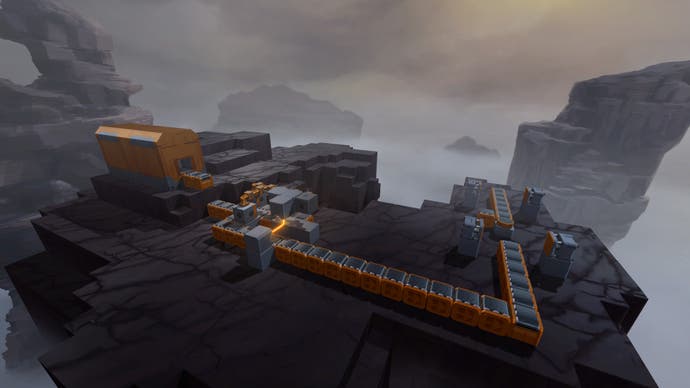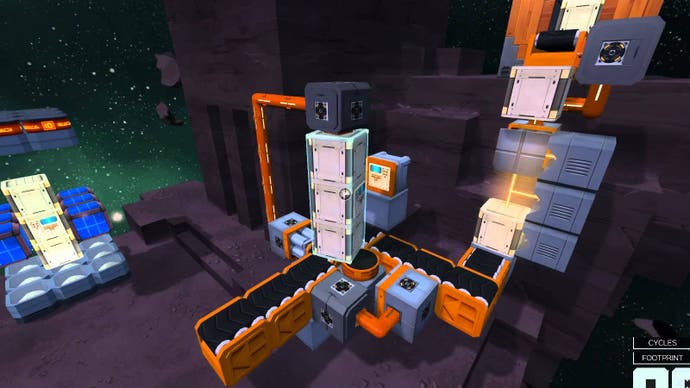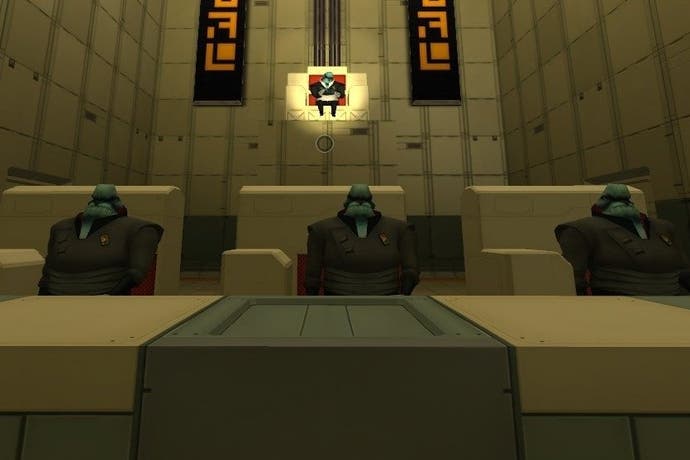Infinifactory review
Spitting bricks.
It turns out that the life of the average sweatshop factory worker is no more comfortable in space than here on Earth. After a day spent working the craters, you must return to a cell (provided by your employers, a race of tall-shouldered, gruff aliens) where your only comfort is a pillow-free bed, a pile of brown food pellets and, if you've been performing well, perhaps an old VHS tape to keep you company (sans player, or TV).
Out in the field things aren't much better. Space-suited bodies of fallen workers lay slumped against rocks, usually clutching an audio recording (dubbed, miserably, a 'failure log') on which their final words are recorded. There are no toilet breaks and you can forget about joining a union (for one thing, the only colleagues you ever meet are dead ones). While you're provided with a jetpack, useful for hovering over your workplace to gain a better vantage point on the day's work, if you step off the edge of a cliff and forget to engage the boosters... Well, let's just say there is no health and safety officer here on the Infinifactory floor.
It's not all bad here in the galactic factory, though. For one thing, the work itself is provides a glorious challenge and diversion. It's easy to forget about worker's rights when your job is, essentially, to solve spatial cryptic crosswords. Your task each day is simple: guide an incoming stream of cargo blocks to an exit point by laying a conveyor belt, segment by segment. When you're satisfied you've completed the task, you start the motor. The cargo must land on the conveyor and arrive at its destination intact, and in the correct alignment. In most cases, you need only send ten blocks to the exit to complete the day's work, at which point you're returned to your cell.

This fundamental job description barely changes throughout your career, but the complexity of the challenge scales alarmingly. Initially, you need only lay an unbroken string of conveyor bricks around obstacles to guide the cargo to its destination. But soon your employers introduce new stipulations such as particular arrangements of blocks, or cargo that's been diverted to arrive at multiple destinations.
As the demands expand, so too does your stock of tools. Soon you're provided access to Sensor Blocks, which can be paired with Pusher Blocks (using conduit pipes that link the two). When one block passes next to a Sensor, the Pusher will trigger, shunting another block elsewhere on your network of conveyor belts onto a new pathway, allowing you to split the load. There are 'Welder Blocks', which allow you to fuse cargo together into wild shapes, or Rotator Blocks, which will allow you to spin the bricks in 45-degree increments. Enormous variety and ingenuity derives from a relatively small palette of tools (just eighteen different block types, in total).
While the earliest puzzles can usually be solved simply by hovering above the stage and making a diligent mental plan, soon enough you'll need to use trial and error to test your solutions, ironing out issues and perfecting the timings of your belts. When things go wrong, the flaw in your plan is immediately obvious. It becomes a game about tinkering, about inching toward a solution in incremental steps of tuning.
In essence, these are logic board puzzles, and you are creating great chains of cause and effect. When you're grubby and lost midway through a solution, and your ideas lay scattered around the stage, Infinifactory tests your tenacity. But when you finally crack a solution, flick the switch to start the belts and watch as your wonder machine whirs into life, the rush of satisfaction is unusually quick. This is not a game that makes you feel smart so much as a game that draws the smart out of you; it surprises you with your own inventiveness. As a result, the moment that you complete a puzzle the egg timer of your resolve is flipped. You begin the next challenge fresh and heroically emboldened.

When you complete a challenge, results screen presents a trio of bar charts that compare your performance to that of other players (the number of cycles, footprints and blocks you used). This often reveals a difficult truth: there's always a way to fine-tune your design and optimise the machine. It also illustrates another of the game's enviable qualities: these puzzles can be solved in myriad ways. There is no single correct answer. Rather, you have an opportunity to express your own particular type of design and ingenuity in crafting a solution. Despite their mundane titles ('Munitions Refill Type Six', 'Wave Detection Array') each challenge is an opportunity for rude creativity, never a combination lock with a single, dull solution.
Each of the five sets of puzzles is bookended with a performance review with your alien masters, who present you with a prize for your efforts before being returned to your cell, where you can arrange your trophies (or hurl them against the sparse walls), and eat. Through these segments and the audio logs, a contextualising story emerges, if you're interested. But Infinifactory's rich and thick appeal is in the nuts and screws of the manual labour. You may not enjoy many worker's rights here, in the employ of this sour-faced alien management team, but the job satisfaction? It's unrivalled.


